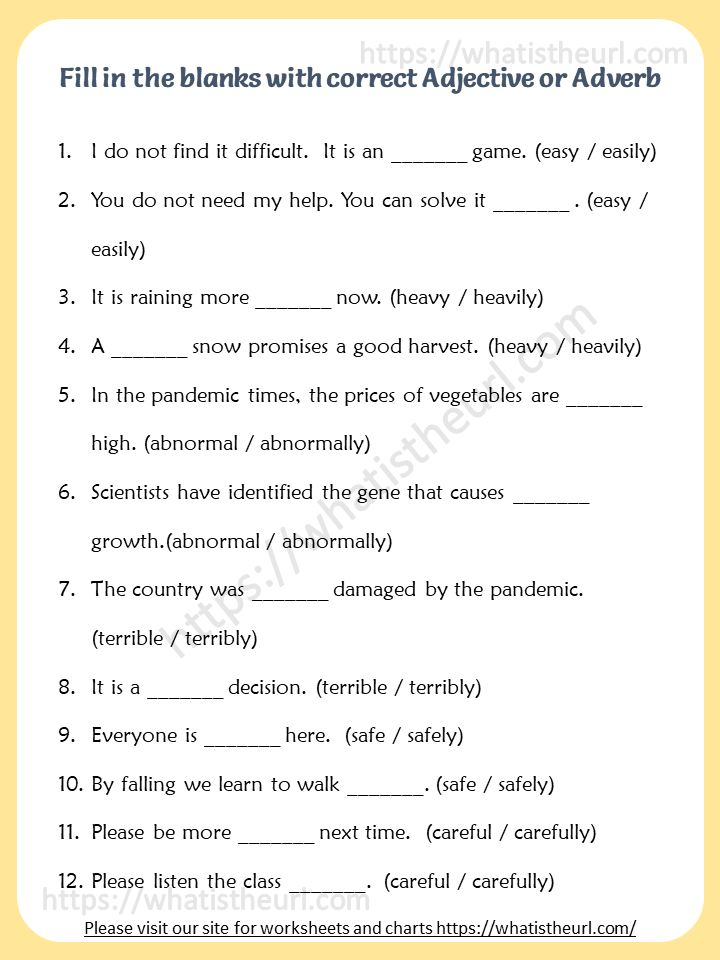Adverbs Of Intensity Worksheets With Answers – Adverbs are used to describe the meaning of a verb, adjective or an adjectival. Adverbs are used to indicate when, where, or how something happened. They are typically used prior to the adjective, verb, or verb they alter.
Here are some additional examples.
He ran quickly.
She sang beautifully.
They can fluently speak English.
There are many possibilities to make adjectives. As you can notice that there are many ways to make adjectives. It is possible to create additional Adverbs by mixing words.
He drives slowly.
He arrived at the right time.
Adverbs can be placed at either the beginning or end a sentence. The function of the Adverb determines its position.
As you can see, the modifiers of verbs usually go in the direction of the verb. Adverbs that modify adjectives or any other adverbs should be placed prior to the adjective or other anagram it is changing.
For example:
He is a slow driver. (incorrect)
He is a slow car. (correct)
He drives slowly. (correct)
They showed up promptly. (correct)
They were there very quickly. (incorrect)
Let’s take a look at adverbs. These worksheets allow you to practice using the adverbs within sentences. The worksheets are split into three sections that cover the identification and use of adverbs and creating adverbs.
The first step is to go through several sentences and identify the adjectives. The first part focuses on the recognition of adverbs. The next section, Adverbs, will help you practice using adverbs to distinguish adjectives and verbs. The third section is about creating Adverbs. It will show you how adjectives can be transformed into adverbs.
Are you ready to get started? Grab a pencil and get to work with these worksheets for adverbs.
Adverb Worksheets: Types and their uses
Adverbs are words which describes a verb an adjective, or a different word. Adverbs are used to indicate when, where, how and for what reason. Adverbs are usually used after a specific verb.
He slowly moved through the space.
For example, most adjectival terms can be constructed by adding an -ly after an adjective.
Adjective slow
Adverb: slowly
Adjective: quick
Adverb: quickly
Adjective: hard
Adverb: Hard
Adverbs could be a multi-word or one-word word. A good example of a one-word adjectival is the form -ly.
Slowly, he moved through the room.
Multi-word adverbs consist of many words, like:
He was slow to move around the room.
Here are some of the most common multi-word adjectives:
adverb + adverb: quite slowly, extremely quickly
Adverb + adjective: Very hot or very cold
Preposition + adverb: without delay, at the front
There are two types of adjectival terms.
1. Adverbs that describe how
The fashion adverbs tell us what should be done. Let’s look at this example:
He moved slowly through every room.
The sentence is slowly telling us the way the man moved.
These are only the most common adverbs to describe the ways in which they work.
In a slow, steady, and quiet manner and loudly.
2. Place-related Adverbs
Place adverbs tell us where something has been done. Consider this example:
He moved around the room.
The adverb across in this sentence lets us know where he has taken a walk.
Here are just a few examples:
Outside, upstairs, downstairs and everywhere else
There are also adverbs to describe frequency and duration. Adverbs that indicate the duration of time, like “when something has been completed”, are also available.
He slowly moved through every room.
This sentence uses slow as an adverb.
Adverb Worksheets: Tips and tricks
Adverbs may be words that modify the meaning of a verb or adjectives. These worksheets will help you show your students how to utilize adverbs. Here are some helpful tips and tricks to maximize the use of the worksheets for adverbs.
1. A variety of sentences can be made use of.
You can use adverbs in many different sentences. Be sure to play around with your worksheets. It is possible to include simple sentences, as well as more complicated sentences and even questions. This will allow students to discover the many ways to use adjectival terms.
2. Highlight using the adjectival
When creating worksheets, make sure to highlight the adverbs in every sentence. This makes it easier for your students to recognize them. Make sure to highlight all adverbs with one color, or use the color of a different one to represent each sentence.
3. Let your students make their own sentences.
Your students shouldn’t just fill in the blanks on worksheets, but also have to create sentences with adverbs. They will be able better be able to comprehend the writing of adjectival terms.
FAQs: Adverb Worksheets
1. What are adverbs, you ask?
An adverb is a description of an adjective or verb or any other word. Adverbs are used in order to identify when and where an action is taking place. They are usually adverbs that end with -ly.
2. There are four primary types of adverbs that are able to use.
There are four types.
3. What can I do with adjectival phrases to enhance my writing?
Adverbs are used to describe verbs and adjectives. Adverbs help create writing that is more engaging and descriptive.
4. What are some of the most frequently used adverbs?
Common adverbs: quickly slow; slowly; poorly; well; well; hard and soft late and early Never, never; Sometimes, but usually.






